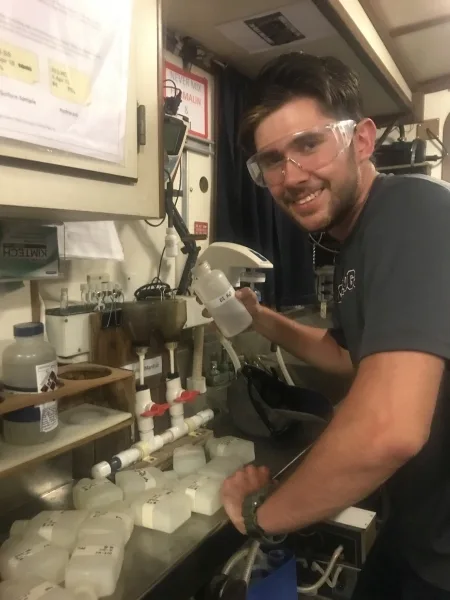Programs Blog
Busy at work in the lab

Jason Gonsalves, B Watch, University of Redlands
Ship’s Log
Current Position
3°38.213’ S, 169°25.948’W
Ship’s Heading and Speed
357°, 6.5 kts
Sail Plan
Starboard tack under all of the four lowers except the Jib: Mains’l, Main Stays’l, Fore Stays’l. The Jib Tops’l was raised earlier but was taken down in the evening.
Weather
Clear and warm during the morning and evening with scattered Cumulus clouds. Some short afternoon squalls during watch turnover.
Chief Scientist Blaire invited me to post the blog today, so I did. I’m writing to you as I slowly emerge from self-imposed bunk stasis; I have been double-sick since last Friday just before we left port in Pago Pago. The combination of a cold and sea sickness had really done a number on the physicality of my being, the nature of my presence and the morale of my mind. It’s been a few days now since that all started, and I can say with confidence that I’m well and back at my full potential. This is great, because now I can really enjoy the full and inspiring experience that is the Robert C. Seamans!
Today was a particularly relaxing day; 0700-1300 morning watch for B-Watch (my group) alongside a quick mentoring session for research projects later in the afternoon. The students of S-287 are working on their first assignment for Chief Scientist Blaire. It’s an equipment diagram for an object of choice used in any form of data collection or processing. I myself chose the Chlorophyll-A Filtration Manifold, which allows us to collect chlorophyll cells on filter paper by filtering them out from water samples. This gave me an opportunity to cozy in to the Dry Lab where the apparatus is located and make sure I understand how it works. The Dry Lab is also air conditioned (the only spot on ship that is), which makes any length of time there truly worthwhile.
Being exposed to open fieldwork and then processing in lab has really impacted my growing interest in marine science in a positive way. I haven’t actually deployed any yet, but seeing the Tucker Trawls and the Neuston Nets being deployed at higher and higher frequencies has made me incredibly excited to do one of my own. We’ve already pulled a lot from the tows such as Fish Larvae, Copepods, Shrimp Larvae and other micro fauna. When I’ve been in lab so far, I’ve been mostly processing data instead of taking part in the collection of data (just how the Watch rotations worked out, it’ll change soon). That’s been almost more invigorating, I’ve found, as I get to test lots of oceanic attributes such as pH and chl-A concentrations. I’ve also taken part in 100-counts of biomass samples from the Neuston Nets and Tucker Trawls. I’m really enjoying lab; it was the main thing keeping my grounded through all the sickness and continues to really invoke my passion every day.
To my mom and dad, thank you for helping me be on this amazing trip at sea – I love and miss you guys! To my rock who I’m especially missing today (because I just finally got better and you would be the person I’d want to spend time with instantly after), I love you so much Nikki. I’m counting down the days until I see you again!
– Jason Gonsalves, B Watch, University of Redlands
Recent Posts from the Ships
- Ocean Classroom 2024-A collaborative high school program with Proctor Academy
- Collaborations and Long-term Commitments: SEA’s Caribbean Reef Program Sets a Course for Coastal Programs that Compliment Shipboard Experiences.
- Sea Education Association students prepare for life underway using state of the art nautical simulation from Wartsila Corporation.
- SEA Writer 2022, Magazines From the Summer SEA Quest Students
- Technology@SEA: Upgrades Allow Insight into Ocean Depths
Programs
- Gap Year
- Ocean Exploration
- High School
- Science at SEA
- SEA Expedition
- SEAScape
- Pre-College
- Proctor Ocean Classroom
- Protecting the Phoenix Islands
- SPICE
- Stanford@SEA
- Undergraduate
- Climate and Society
- Climate Change and Coastal Resilience
- Coral Reef Conservation
- Marine Biodiversity and Conservation
- MBL
- Ocean Exploration: Plastics
- Ocean Policy: Marine Protected Areas
- Oceans and Climate
- Pacific Reef Expedition
- The Global Ocean: Hawai'i
- The Global Ocean: New Zealand